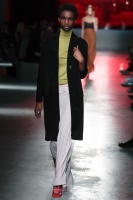Key staff depart Prada, as house struggles to reverse declining sales
By Astrid Wendlandt - 27 June 2018
Several senior key figures have left Prada Group in recent months as the improved performance and strategic changes promised by CEO Patrizio Bertelli are taking longer than hoped to materialize, according to industry sources.
Prada on Thursday confirmed the exits of Strategic Marketing Director Stefano Cantino (pictured) and Prada brand Marketing Director Aldo Gotti
The Italian brand, which missed the sneaker, sportswear and e-commerce booms, is reorganizing its management in a bid to stem four years of declining like-for-like sales. Prada on Thursday confirmed the exits of Strategic Marketing Director Stefano Cantino and Prada brand Marketing Director Aldo Gotti. Cantino, who oversaw marketing, communication and licenses, had been with Prada for 21 years. Gotti, who was worldwide Miu Miu commercial director and played a key role in the brand’s development, had been with the group for 28 years.
“The Prada group is in constant evolution and this is part of a normal internal turnover,” a spokeswoman for the group told FashionNetwork.com. “The number of employees is currently growing at all levels, in particular with regards to the Italian headquarters and specifically in the communications area.”
The Prada spokeswoman said it was hiring new people to strengthen its management teams but declined to give their names and function. She would only say that Cantino and Gotti would not be replaced.
Several other key senior figures have fled the group in recent months, FashionNetwork.com has learnt from industry sources who spoke on condition of anonymity. These include Gherardo Felloni, ex-Dior Couture and Miu Miu’s shoe and bags maestro, who left to become artistic director of Roger Vivier three months ago. Francesca Bertoncini, Prada retail merchandise director for shoes, started as VP merchandising for Stuart Weitzman four months ago. And Serge Carreira, retail merchandising director for Prada ready-to-wear, who left last summer to become CEO of British fashion label Mary Katrantzou. Prada declined to comment on their departures.
At the time of the group’s full-year results in March, Bertelli said Prada was starting to see concrete benefits from its numerous strategic initiatives currently under way and was expecting a return to growth in 2018.
“At every trading update, Bertelli promises the company will change things but that does not happen,” one of sources who worked for Prada said on condition of anonymity. “So those who want change leave to find it elsewhere.”
The group, which also owns shoe labels Church’s and Car Shoe, only began fully embracing the Internet three years ago, much later than arch-rivals such as Gucci and Louis Vuitton which invested heavily in digital communications and e-commerce. Prada, along with other Italian brands Salvatore Ferragamo and Tod’s, have been struggling to engage successfully with digitally savvy millennial consumers. They have not benefited as much as their peers from the Chinese-led luxury spending rebound of the past year, analysts have said. “Prada seems indeed less attuned to “new luxury” than Gucci and Louis Vuitton. Updating the management team may be a good step – in the same way as they are catching up in digital,” said Luca Solca, head of luxury goods research at Exane BNP Paribas.
This week, Ferragamo lost its head of marketing and communications Antonio Burrello, who had been hired in January 2017 by former CEO Eraldo Poletto, who himself left in March to run Stuart Weitzman.
While Prada’s ready-to-wear collections are still revered by fashion critics, its designs could be refreshed, some industry analysts have said. “Prada’s esthetics seem to not be sufficiently attractive for young people, it is looking increasingly rigid compared to others,” one of the industry sources said. “Which is a shame since its vintage and baroque concept is very much in the air - as the success of Gucci and Yves Saint Laurent show - only these two brands bring a fresh twist and interpretation.”
Prada said Fabio Zambernardi, Cantino’s long-standing partner and right-hand man of Miuccia Prada at her design studio, remained in place.
Prada has been downsizing its global retail network after an aggressive worldwide expansion that has harmed its exclusive image and dented profits. Analysts also said the brand raised prices too high and too fast without introducing enough novelty at the entry and middle-price ranges. For many years, Prada failed to produce a powerful successor to its best-selling Saffiano Galleria tote and sufficient new designs for its popular nylon bags. Prada’s shares, currently trading in Hong Kong at HK$ 36, are still below their 2011 flotation price of HK$ 39.5 after touching a high of more than HK$ 80 in September 2013. Nonetheless, based on hopes of recovery and testifying to the brand’s unique reputation as Italy’s most creative fashion marque this century, Prada shares have been trading at a premium to its peers of between 35-40 times prospective earnings, compared to the industry average of around 31 times and LVMH which is on around 30 times.
Bertelli said earlier this month that Prada was not for sale and he hoped his thirty-year-old son Lorenzo, head of digital communications since September, could succeed him one day if he so wished.
“Digital and consumer intelligence are two of the most sought-after competencies in the luxury industry in this moment, as there is a growing understanding in the sector that these two areas of expertise can drive significant competitive advantage in a fast-changing market environment,” said Mario Ortelli, who used to cover the luxury sector at Bernstein and now runs his own M&A boutique. “The majority of luxury companies are reinforcing their organizational structures in these areas, creating ad hoc functions and hiring new managers with proven skills in these areas, also coming from other industries like Internet and technology companies.”







